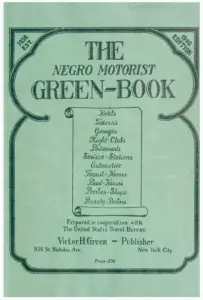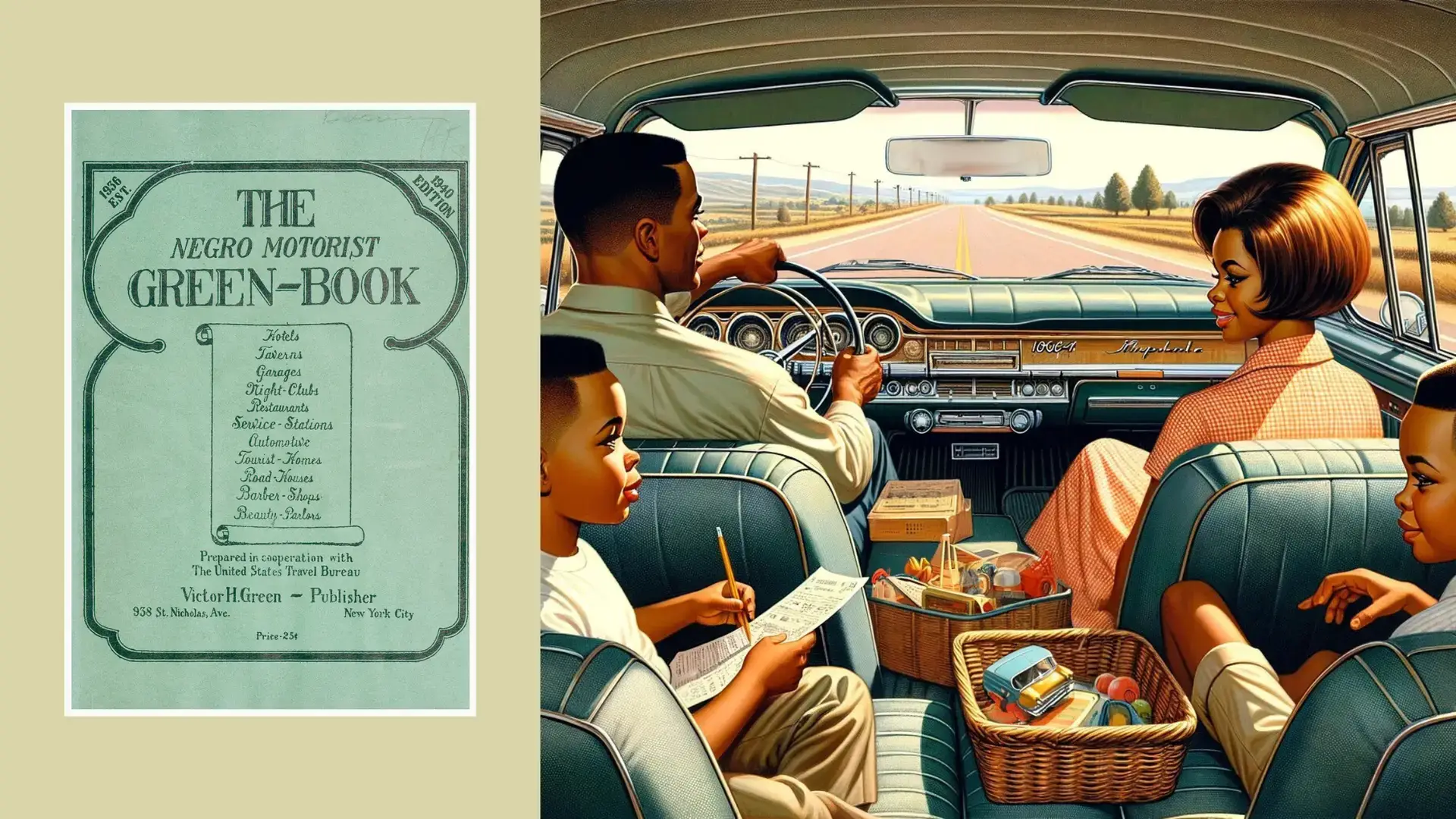In the shadow of the Great Migration, Victor Hugo Green’s Green Book emerged as a pivotal navigator for African American travels during an era beset by the harsh realities of Jim Crow laws and the looming threat of sundown towns. This essential guide was crafted with a singular vision: “to provide the Negro traveler information that will keep him from running into difficulties, embarrassments and to make his trips more enjoyable,” as Green fervently believed. His work was a testament to the strength and resilience of a community in pursuit of freedom and dignity on the open road.
It was a time when highways were not just ribbons of asphalt leading to new experiences and adventures but represented a maze of dangers and threats for the African American motorist. Finding a safe pit stop wasn’t just about car tires and fuel; it was a game of survival where potential perils cornered travelers at every turn. However, Victor Hugo Green changed this nerve-wracking narrative by crafting an essential travel guide. This significant lifeline offered a haven amidst a desolate landscape.
The Great Migration
Understanding the pivotal importance of these guides requires us to step back into an era known as The Great Migration. This was the exodus of about 6 million African Americans from the Jim Crow South to the northern and western regions of America between 1916 and 1970. Economic struggles in the southern states prompted this mass movement, notably by the boll weevil infestation that crushed cotton crops and led to the demise of the local agrarian economies. Enticed by the prospects of industrial jobs in the north, African Americans migrated en masse. However, while they left behind the blatantly racist segregation of the southern states, they confronted a raft of new discriminative practices in the north.

Emergence of the Black Middle Class
As time moved through the 1930s, African Americans began to enter the middle class as they secured jobs in the cities. They earn wages well above the meager subsistence levels they etched out by the exploitative labor practices of tenant farming and sharecropping in the Deep South. Innovation in modern machinery spawned a significant stride in longevity and self-reliance within the African American communities – car ownership. Despite being seen as a luxury due to its exorbitant price, car ownership swiftly became a symbol of independence and empowerment, particularly as it presented an alternative to the highly segregated public transportation system. Yet, with the increase in car ownership amongst African Americans also came the hazards associated with intercity travel during the blatant era of segregation, known as the Jim Crow era.

Victor Hugo Green - Travel Writer
The story takes an inspiring twist when we introduce Victor Hugo Green – a WWI veteran and postal worker turned entrepreneur and travel writer with a dream – to provide a safer journey for his fellow African Americans. Victor Hugo Green harnessed his observations into action, turning his abundant knowledge about routes and city layouts that he’d obtained being a postal worker into publishing the first Negro Motorist Green Book in 1936.
The Negro Motorist Green Book, shortened to The Green Book, continuously updated until 1964, when the Civil Rights Act deemed it unnecessary, was more than just a directory. It was a literal beacon of hope for black motorists navigating the tense roads of America. The Green Book listed businesses and places that provided shelter to denied, intimidated African American travelers, mitigating the fretful possibility of denied access to facilities or violence.
The Civil Rights Act of 1964
Victor Hugo Green’s legacy and ingenious creation of the Green Book provided safe travel resources and reinforced empowerment within the African American community. As we recount crucial events from the Great Migration and the Civil Rights era, the Green Book is a poignant symbol of the resilience of the African American community faced with systemic racism.

Sundown Towns
Surprisingly, even today, some sundown towns (towns or municipalities that excluded nonwhite people—most frequently African Americans from remaining there after sunset, under threat of violence) still cast a shadow across the nation. These grim reminders tell us that social progress is an ongoing journey. The legacy of Victor Green and his groundbreaking guide serves as a reminder, echoing messages of resilience and determination. Even though the Green Book may not physically guide African American motorists anymore, its stories and conversations fuel the drive toward change, equality, and justice.
An Immense Contribution
Victor Hugo Green’s immense contribution should be amplified. Keeping his memory alive serves as a tribute to the struggles and experiences of the African American traveler of yore – formerly the Negro Motorist. Their story and legacy persist. Just as the Smithsonian Institution’s online exhibit keeps the spirit and stories of the Green Book alive, we must ensure the embers of these tales of survival, triumph, resilience, and struggles do not fade away.

Traveling North and The Harlem Reniassance.
The African-American migration to Northern cities led to the emergence of a new urban African-American culture known as the Harlem Renaissance. It was a golden age in African-American culture, manifested in literature, music, stage performance, and art, with prominent figures like Langston Hughes, Zora Neale Hurston, Aaron Douglas, Claude McKay, Duke Ellington, and Cab Calloway. Their contributions left an infinite mark on recognizing American and European culture. Want to know more? Read “A Traveler’s Guide to Marseille’s Diverse Culture: Exploring Black Heritage, Ancient History, Jazz, Food, and Wine.”
To start planning your Black Heritage Vacation, submit a Vacation Request and receive a Courtesy Consultation.











14 Responses
Hello,
I enjoyed the focus on Victor Hugo Green’s personal journey, from a WWI veteran and postal worker to an entrepreneur and travel writer with a mission. This added a human touch for me that I truly appreciated. The Green Book’s role as a beacon of hope for black motorists, offering a guide to safe havens amidst the dangers of segregation, is effectively portrayed.
The connection between the Green Book and the Civil Rights Act of 1964 highlights the evolving landscape of racial dynamics in America. The article successfully underscores the importance of Victor Hugo Green’s legacy and the lasting impact of his ingenious creation.
Thank you for sharing such a thought provoking and informative post. I really enjoyed it.
Starlight, I’m glad you enjoyed it. My parents and many other relatives were a part of The Great Migration. I grew up in NY but traveled south to visit my grandparents in South Carolina by car many times when my sister and I were small. They used to talk about The Green Book. Thank you for your comments.
Thank you. These stories need to continue to be told. The strength and endurance of black people throughout centuries of enslavement to freedom is inspiring. They didn’t let circumstances dictate their outcome. What a testament and example for us to follow. Great article
Indeed Dr Canida. There are so many more just like this one that need telling. Let’s keep the conversation going. Thanks for your comments.
Cheers!
Hey ! Your article brilliantly explores the historical significance of Victor Hugo Green’s Green Book during the Great Migration, shedding light on its crucial role in ensuring the safety and dignity of African American travelers amidst the challenges of Jim Crow laws and sundown towns. You effectively capture the essence of the era, detailing the emergence of the black middle class and the innovations that led to increased car ownership among African Americans. Well done . Thank you for sharing!
Glad I could be of assistance. Thank you for your kind comments Ela.
Hi, thanks for the informative article that sheds light on a subject that, in my opinion, should not exist, but sadly it does. I have never heard of the green book prior to reading your article. As someone who is in a bi-racial relationship, I do my best to understand my girlfriend’s struggles. It’s not that I’m completely clueless but it is to say that I’m still learning after all the time we’ve spent together. I will share your article with her and I’m sure it will be fodder for good conversation.
Bob
Hi Bob,
There are many stories like these that people don’t hear or read about. Sometimes, people hope to forget and don’t want to recount negative experiences. While others have told their stories, but those stories have been hidden.
But if you really want to understand your girlfriend’s struggle, I encourage you to visit the Smithsonian National Museum of African American History and Culture in Washington, DC (If you haven’t already). I am glad this story intrigued you, and you want to understand your girlfriend’s experience. History can be an eye-opener. It also helps us all avoid repeating the mistakes of the past.
Thanks for your insightful comments!
Reading your post was like stepping into a time machine, whisking me back to a history lesson I never knew I needed. I remember, at the tender age of 5, sitting wide-eyed as my grandpa unfolded the legacy of Victor Hugo Green and his Green Book. It was more than just a story; it was a revelation about the strength and resilience within my own heritage.
Grandpa’s voice, rich with emotion and pride, painted vivid pictures of a time when the open road was a treacherous path for African Americans. He spoke of the Green Book as a beacon of hope, a guide crafted from necessity but built on dreams of freedom and dignity. Through his words, I learned about the courage of those who dared to travel, armed with nothing but their wits and Victor Hugo Green’s lifesaving compilation.
Your article captures the essence of what my grandpa imparted to me: the Green Book wasn’t merely a travel guide; it was a testament to the indomitable spirit of the African American community. It symbolized a refusal to be confined by the oppressive shackles of Jim Crow, a bold declaration of the right to explore and thrive within the vast landscapes of America.
As I grew older, my fascination with the horror genre in anime blossomed, yet the tales of Victor Hugo Green and his Green Book remained a powerful reminder of real-life horrors and triumphs. It’s a narrative of navigating through literal and metaphorical haunted landscapes, drawing parallels with the eerie and resilient paths characters in horror anime often tread.
Thank you for reigniting the memories of those evenings with grandpa and for shining a light on such a pivotal piece of history. Victor Hugo Green’s legacy, much like the tales woven in horror anime, underscores the complexities of fear, courage, and the relentless pursuit of freedom. Your post is a bridge connecting past struggles with present-day reflections, a reminder that while we’ve traveled far, the journey continues.
Sincere Thanks,
S
Steve, I so appreciate your thoughtful comments! It warms my heart to hear that your grandpa passed a little piece of your own history and heritage to you. It is indeed a story of courage, inventiveness, and grit of African American strugge for freedom and survival while pursuing it. Bravo Steve. you nailed it! And kudos to Grandpa.
Cheers!
Priscilla Holmes
CEO Cilla Travel LLC
This was a neat peek into history. The green book must have been invaluable to African American citizens. I think it’s remarkable how resilient people are, and how good at building community and community knowledge. We have more methods for sharing wisdom and experience now, but the core ideas are the same: to connect, share knowledge, and influence the way society advances.
Thank you fir your comments Jessica.
Cheers!
Thanks so much for sharing this information and providing the education everyone needs to better understand history and Victor Hugo Green and his Green Book. I appreciate learning the truth of the journey of African Americans and their many challenges—dreams of freedom and honor for these folks possessing so much courage.
This book transcends being merely a travel guide and captures the essence of the African American community. This is a powerful reminder of the inhumanity at that time but the ability to move beyond and triumph. Bringing light to this part of history is important as we continue to grow and understand life as a journey among equals filled with unconditional love. This article helps the awakening.
Thank you for your comments Joseph. They are much appreciated.
Cheers!🥂